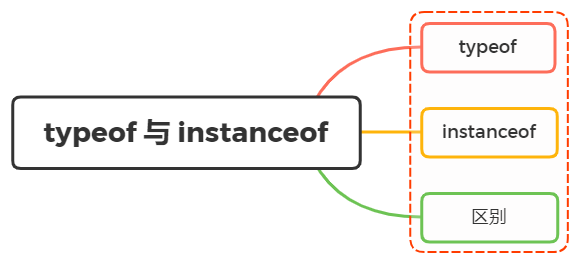面试官:typeof 与 instanceof 区别

一、typeof
typeof 操作符返回一个字符串,表示未经计算的操作数的类型
使用方法如下:
typeof operand
typeof(operand)typeof operand
typeof(operand)operand表示对象或原始值的表达式,其类型将被返回
举个例子
typeof 1 // 'number'
typeof '1' // 'string'
typeof undefined // 'undefined'
typeof true // 'boolean'
typeof Symbol() // 'symbol'
typeof null // 'object'
typeof [] // 'object'
typeof {} // 'object'
typeof console // 'object'
typeof console.log // 'function'typeof 1 // 'number'
typeof '1' // 'string'
typeof undefined // 'undefined'
typeof true // 'boolean'
typeof Symbol() // 'symbol'
typeof null // 'object'
typeof [] // 'object'
typeof {} // 'object'
typeof console // 'object'
typeof console.log // 'function'从上面例子,前6个都是基础数据类型。虽然typeof null为object,但这只是 JavaScript 存在的一个悠久 Bug,不代表null 就是引用数据类型,并且null 本身也不是对象
所以,null 在 typeof 之后返回的是有问题的结果,不能作为判断null的方法。如果你需要在 if 语句中判断是否为 null,直接通过===null来判断就好
同时,可以发现引用类型数据,用typeof来判断的话,除了function会被识别出来之外,其余的都输出object
如果我们想要判断一个变量是否存在,可以使用typeof:(不能使用if(a), 若a未声明,则报错)
if(typeof a != 'undefined'){
//变量存在
}if(typeof a != 'undefined'){
//变量存在
}二、instanceof
instanceof 运算符用于检测构造函数的 prototype 属性是否出现在某个实例对象的原型链上
使用如下:
object instanceof constructorobject instanceof constructorobject为实例对象,constructor为构造函数
构造函数通过new可以实例对象,instanceof 能判断这个对象是否是之前那个构造函数生成的对象
// 定义构建函数
let Car = function() {}
let benz = new Car()
benz instanceof Car // true
let car = new String('xxx')
car instanceof String // true
let str = 'xxx'
str instanceof String // false// 定义构建函数
let Car = function() {}
let benz = new Car()
benz instanceof Car // true
let car = new String('xxx')
car instanceof String // true
let str = 'xxx'
str instanceof String // false关于instanceof的实现原理,可以参考下面:
function myInstanceof(left, right) {
// 这里先用typeof来判断基础数据类型,如果是,直接返回false
if(typeof left !== 'object' || left === null) return false;
// getProtypeOf是Object对象自带的API,能够拿到参数的原型对象
let proto = Object.getPrototypeOf(left);
while(true) {
if(proto === null) return false;
if(proto === right.prototype) return true;//找到相同原型对象,返回true
proto = Object.getPrototypeof(proto);
}
}function myInstanceof(left, right) {
// 这里先用typeof来判断基础数据类型,如果是,直接返回false
if(typeof left !== 'object' || left === null) return false;
// getProtypeOf是Object对象自带的API,能够拿到参数的原型对象
let proto = Object.getPrototypeOf(left);
while(true) {
if(proto === null) return false;
if(proto === right.prototype) return true;//找到相同原型对象,返回true
proto = Object.getPrototypeof(proto);
}
}也就是顺着原型链去找,直到找到相同的原型对象,返回true,否则为false
三、区别
typeof与instanceof都是判断数据类型的方法,区别如下:
typeof会返回一个变量的基本类型,instanceof返回的是一个布尔值instanceof可以准确地判断复杂引用数据类型,但是不能正确判断基础数据类型而
typeof也存在弊端,它虽然可以判断基础数据类型(null除外),但是引用数据类型中,除了function类型以外,其他的也无法判断
可以看到,上述两种方法都有弊端,并不能满足所有场景的需求
如果需要通用检测数据类型,可以采用Object.prototype.toString,调用该方法,统一返回格式“[object Xxx]” 的字符串
如下
Object.prototype.toString({}) // "[object Object]"
Object.prototype.toString.call({}) // 同上结果,加上call也ok
Object.prototype.toString.call(1) // "[object Number]"
Object.prototype.toString.call('1') // "[object String]"
Object.prototype.toString.call(true) // "[object Boolean]"
Object.prototype.toString.call(function(){}) // "[object Function]"
Object.prototype.toString.call(null) //"[object Null]"
Object.prototype.toString.call(undefined) //"[object Undefined]"
Object.prototype.toString.call(/123/g) //"[object RegExp]"
Object.prototype.toString.call(new Date()) //"[object Date]"
Object.prototype.toString.call([]) //"[object Array]"
Object.prototype.toString.call(document) //"[object HTMLDocument]"
Object.prototype.toString.call(window) //"[object Window]"Object.prototype.toString({}) // "[object Object]"
Object.prototype.toString.call({}) // 同上结果,加上call也ok
Object.prototype.toString.call(1) // "[object Number]"
Object.prototype.toString.call('1') // "[object String]"
Object.prototype.toString.call(true) // "[object Boolean]"
Object.prototype.toString.call(function(){}) // "[object Function]"
Object.prototype.toString.call(null) //"[object Null]"
Object.prototype.toString.call(undefined) //"[object Undefined]"
Object.prototype.toString.call(/123/g) //"[object RegExp]"
Object.prototype.toString.call(new Date()) //"[object Date]"
Object.prototype.toString.call([]) //"[object Array]"
Object.prototype.toString.call(document) //"[object HTMLDocument]"
Object.prototype.toString.call(window) //"[object Window]"了解了toString的基本用法,下面就实现一个全局通用的数据类型判断方法
function getType(obj){
let type = typeof obj;
if (type !== "object") { // 先进行typeof判断,如果是基础数据类型,直接返回
return type;
}
// 对于typeof返回结果是object的,再进行如下的判断,正则返回结果
return Object.prototype.toString.call(obj).replace(/^\[object (\S+)\]$/, '$1');
}function getType(obj){
let type = typeof obj;
if (type !== "object") { // 先进行typeof判断,如果是基础数据类型,直接返回
return type;
}
// 对于typeof返回结果是object的,再进行如下的判断,正则返回结果
return Object.prototype.toString.call(obj).replace(/^\[object (\S+)\]$/, '$1');
}使用如下
getType([]) // "Array" typeof []是object,因此toString返回
getType('123') // "string" typeof 直接返回
getType(window) // "Window" toString返回
getType(null) // "Null"首字母大写,typeof null是object,需toString来判断
getType(undefined) // "undefined" typeof 直接返回
getType() // "undefined" typeof 直接返回
getType(function(){}) // "function" typeof能判断,因此首字母小写
getType(/123/g) //"RegExp" toString返回getType([]) // "Array" typeof []是object,因此toString返回
getType('123') // "string" typeof 直接返回
getType(window) // "Window" toString返回
getType(null) // "Null"首字母大写,typeof null是object,需toString来判断
getType(undefined) // "undefined" typeof 直接返回
getType() // "undefined" typeof 直接返回
getType(function(){}) // "function" typeof能判断,因此首字母小写
getType(/123/g) //"RegExp" toString返回